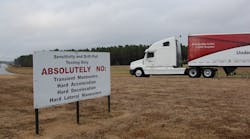GREENVILLE, SC. Changes may be afoot as to the types of testing protocols used to certify heavy trucks and related components to the greenhouse gas emission and fuel economy standards put in place by the Environment Protection Agency (EPA) and National Highway Traffic Safety Administration (NHTSA) several years ago.
“The EPA is discussing the use of coast down testing, wind tunnel testing, and CFD [computational fluid dynamics] for OEMs to meet the greenhouse gas regulations,” Mitch Greenberg, chief commercial officer for aerodynamic device maker SmartTruck Systems, explained here during a coast down testing demonstration held by the company at Michelin’s Laurens Proving Grounds.
“EPA is also discussing adopting similar procedures for the SmartWay program to replace the J1321 fuel test currently being used,” he added.
Mike Henderson, SmartTruck’s chief scientist who served as Boeing’s chief of research for 20-plus years, explained that the J1321 fuel mileage test is “something of a dinosaur” as it’s extraordinary difficult to conduct properly, requiring an inordinate amount of testing time.
For example, he noted that when SmartTruck conducted its J1321 tests in Uvalde, TX, the process took four weeks to complete using two tractor-trailers – one to establish “baseline” fuel economy and the other equipped with its aerodynamic system. By contrast, the coast down testing required only one truck over a two-week time period.
He noted that both tests returned almost exactly the same results as well, with the coast down tests showing SmartTruck’s aerodynamic package provided a 6.5% to 7% gain in fuel economy, with the Uvalde J1321 tests revealing a 6.7% fuel efficiency improvement.
“Coast down testing is the ‘gold standard’ for the EPA for automobiles – it’s a very rigorous protocol,” Henderson noted. Yet it has to be modified for tractor trailers, for while cars weighing 4,000 lbs. typically need 3,000 feet of straightaway to successfully conduct such testing, an empty tractor-trailer with an average combined weight of 37,000 lbs. needs 18,000 feet to run a coast down test – and such long paved straightaways are hard to find.
As a result, SmartTruck did its testing at the Kennedy Space Center, which has an 18,000 foot-long runaway used for a variety of aerodynamic and fuel economy test procedures; even by NASCAR racing teams.
Henderson said data from those tests demonstrated that for heavy vehicles a coast down test can be broken up successfully into two distinct pieces requiring only 5,700 ft. to work with – a “high speed” coast down from 65 mph to 55 mph followed by a “low speed” coast down from 25 mph to zero.
“Coast down testing is very sensitive and very accurate,” he explained. “There’s nowhere to hide; it either works or it doesn’t.”
Henderson also noted that CFD is becoming a far better tool to use in determining vehicle aerodynamic performance and, by extension, fuel efficiency levels – with supercomputers used to run highly complex calculations that allow engineers to examine the impact of drag on every aspect of a vehicle.
“From my background in commercial aviation I can tell you that industry is moving strongly to CFD,” he said. “When I started my career at Boeing, some 25,000 hours of wind tunnel testing were logged to develop the 727 airplane. For the 787 Dreamliner, however, only 5,000 hours were required due to the use of CFD.”
Greenberg added that the trucking industry “is really just getting started” in terms of tapping the capabilities of CFD and coast down tests to improve the aerodynamic profiles of its equipment.
“Cube is king in truck; that’s why the shape of dry van and refrigerated trailers hasn’t changed in 30 years. It’s the perfect shape for hauling freight,” he explained.
“But that’s why we’re starting to see more and more opportunity for aerodynamic development in this area, especially in terms of how we integrate that tractor and trailer together,” Greenberg pointed out. “But you need good measurements and testing to achieve that. That’s why we’re really only getting started. If you really want to control aerodynamic variability, you need good data to do it.”



